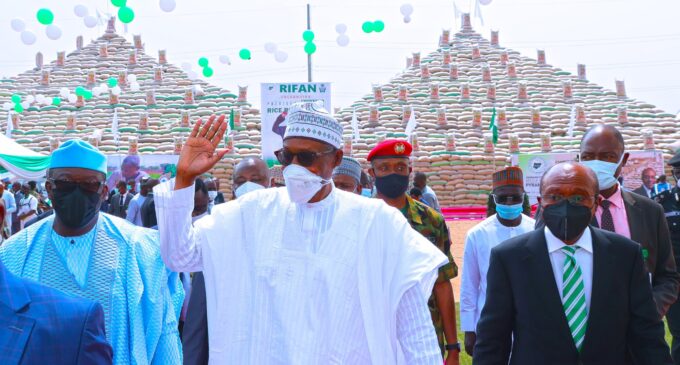Rice O compatriots: Dissecting Emefiele’s rice pyramids

For too long, not much cherry news has been coming out of Nigeria. But despite the woes of insecurity that has practically arrested development in our clime, Godwin Emefiele, governor of Central Bank of Nigeria, CBN through his Anchor Borrowers Program, ABP in partnership with Rice Farmers Association of Nigeria, RIFAN has changed the narrative of Nigeria from doom and gloom to the cherry news of rice pyramids sprouting around Abuja and other cities, especially in the north.
Before dwelling further on the propriety or otherwise of making a public exhibition of rice cultivated in Nigeria as the CBN and RIFAN did on Tuesday, January 18, 2022, in Abuja, it is proper that we put the significance of pyramids in context by underscoring its role from ancient Egyptian and Benin kingdoms to its last manifestation in Kano in the form of groundnut pyramids before its resurfacing in Abuja as rice pyramids which have generated a massive storm in the mass media — both traditional and social.
There are different types of pyramids.
Depending on the shape of the base of the pyramid, they can be classified as a triangular pyramid, square pyramid, and pentagonal pyramid.
The symbolism of rice pyramids which are triangular in shape and sprouted in Abuja is rooted in the groundnut pyramids of yore which loomed large in the skylines of Kano city. That was back in the days when commodities that were at that time referred to as cash crops — groundnut and cotton in the north, cocoa in the southwest, oil palm and coal in the east, and rubber lumps as well as cashew nuts in the south, were the mainstay of the Nigerian economy.
Willy nilly, the visual presentation of a pyramid of any commodity is to demonstrate or create the air of abundance to the masses who behold it.
And pyramids as symbols of power and wealth date back to ancient Egypt under the rule of the pharaohs. Before the British destroyed it in the ancient days when they invaded the palace of the Oba of Benin, a pyramid symbolizing the power and wealth of the Benin kingdom at its peak was located in a strategic corner of the majestic palace of the Oba.
The point l am trying to make is that the overwhelming visual essence of the power of the pyramid has always been optimally utilized by leaders like pharaoh from ancient Egypt, to Oba of Benin in the heydays of Bini kingdom and later emirs of Kano who created groundnut pyramids to project the wealth of the city which was the epicenter of the famous trans Saharan trade.
Although the reality may currently be different, groundnut pyramids in Kano gave people the impression of hope, (true or false) that the commodity was in abundance. Given the scarcity of rice in Nigeria following its ban from being imported by the authorities, and the concerted efforts by both rice farmers and the federal government represented by the CBN that injected the required funds to grow rice locally, it was not unexpected that government would want to show off how successful the initiative has been.
That explains the public display of the abundance of the commodity. It is a sort of assurance to Nigerians that rice is now in surplus, so there is hope that it would soon be in their cooking pots and subsequently in their stomachs.
Somehow, it was envisaged that the rice pyramids showcased in Abuja would generate a positive effect similar to displaying an array of ships bearing petroleum products in our seaports which gave motorists the assurance that fuel scarcity, (which used to be a source of severe distress in Nigeria) was not in the horizon.
It was commonsensical that following the optics of fuel-laden vessels offloading the cargo in the seaports, panic buying of fuel that often caused a run on the fuel stations, were avoided as the masses got the sense that there was an abundant supply of the commodity.
It is in that sense that the rice pyramids were supposed to be a type of symbolism that would project beneficial assurance to Nigerians that their country is now, not only a self-reliant country in rice production but could possibly be a net exporter.
That is what strongly motivated the Rice Showboat in Abuja.
It is rather unfortunate that the initiative, appears to have backfired as some Nigerians are clearly riled up by the fact that a million bags of paddy rice is pilled up in multiple pyramids in Abuja when most of the hoi polloi went through Christmas and new year celebrations without rice being cooked in their kitchens and served in their dining tables, how much more end up in their stomachs which is the ideal place for the rice to be.
As the staple food that is traditionally enjoyed by most folks during periods of festivities, it would have been preferred by Nigerians if the rice pyramids were not in the premises of Abuja chambers of commerce and industry, but in their belly.
Furthermore, the massive public opprobrium that greeted the Abuja rice pyramid display would not be lost on us when it is projected against the backdrop of the fact that there was a time in our country when some Nigerians only ate rice on Xmas day. That is the origin of the phrase Xmas Rice.
It was disheartening that during 2021 end-of-year festivities, the masses were denied that luxury. Which is apparently why someone had to take the flak.
By and large, while the purveyors of the concept for Abuja rice pyramids were altruistic, given the backlash, they may not have engaged in enough critical thinking before birthing and implementing it. Otherwise, they could have identified the potential negative implications and ramifications that just manifested, before embarking on the gambit.
Had they recognized that we are currently in a country where there is a massive trust deficit between the leaders and followers, the negative consequences of the rice pyramids could have been recognized and avoided.
Amongst the myriad of factors responsible for the trust deficit between the authorities and the masses is the recent fallout of #Ensars riots whereby in the course of protesting police brutality, youths discovered and looted warehouses containing essential commodities such as rice, etc which are COVID-19 palliatives meant for the masses but were being selfishly kept in warehouses by government officials for their personal enrichment.
Owing to the #Endsars experience, it is easy for the masses to assume that government is out to once again emasculate them by hoarding the rice that should have been made available to them during Yuletide in the manner that COVID -19 palliatives were hidden from the masses instead of the commodity being distributed to them.
Furthermore, the timing of the rice pyramid display in January is wrong as it could have had a more positive effect if the exhibition was held before the end of year festivities since it could have given the masses hope that there was enough rice in the country to make the end of year festivities enjoyable.
What the scenario described above suggests is that it is a combination of strategic and tactical errors as earlier enumerated that have contributed to ruining an otherwise justifiable action aimed at assuring Nigerians that their country is on the way to being not only self-reliant in rice production but a potential net exporter of the commodity that is a critical staple food in our country. It is unfortunate that instead of being a bold statement that Nigeria is now rice independent, there has been a monumental backlash engendered by rice the pyramids which this article is trying to contextualize so that both the authorities and citizens can become aware of the missing links and the cause of the hoopla with a view to avoiding same mistakes in the future.
If you like, it is a sort of post mortem with a view to putting both the leaders and the followers on the same page.
And I hope that ultimately, this intervention would help clear the fog for government operatives to appreciate the fact that they have to subject their ideas to tests or what is referred to as proof of concept that could be conducted by social scientists before they are applied.
As some of us may recall, the vanishing of the groundnut pyramids in Kano was emblematic of the decline of the economic fortunes of our country, especially with respect to wealth from cash crops generated through farming.
ln reality, the groundnut pyramids in Kano actually disappeared as soon as there was a capacity to process the same into vegetable oil locally.
And the re-enactment of the pyramid image in Abuja on Tuesday, January 18, 2022, was a ploy to rekindle the feeling of abundance of made in Nigeria rice. Clearly, it is the flagship of President Buhari’s legacy projects. It is also along the same line that Mr president recently visited Lagos to commission the sea-going vessels recently built by the Nigerian navy which was a huge accomplishment in the eyes of the incumbent government.
All these events are being launched with pomp and pageantry by virtue of the fact that this administration is coming to its terminal end on May 29, 2023, therefore there is the need for President Buhari to curate his legacy before his imminent exit from Aso Rock Villa so that with the burnishing, posterity may be kind to him.
However, in the light of the dissonance in communication between our leaders and followers, the latter could not see anything good about the rice pyramids which they could only consider to be a stunt-pulling event by the government even when millions of stomachs of the critical masses rumbling due to hunger.
Nevertheless, beyond the symbolism of the sprouting of rice pyramids in Abuja, the partnership between the CBN that provided the funding through one of its economic intervention funds in different sectors and the Rice Farmers Association of Nigeria, RlFAN is remarkable and worthy of closer scrutiny to identify other benefits which have now been lost in the milieu of kudos and knocks triggered by the now infamous rice pyramids.
Based on the exciting news emanating from both the CBN and RlFAN, it is amazing how in a space of less than seven (7) years, Nigeria has progressed from the status of a massive importer of rice estimated to be about 1.2 million metric tons annually valued at over N210 billion in 2014 to about 2,000 metric tons and valued at a mere N400 million in 2021.
The good news above was conveyed by President Buhari in his speech at the pyramids unveiling event. As a skeptic, I had received the incredible statistics on pre and post-ABP/RlCAN rice initiative between 2014 till date with a pinch of salt, until the Thailand Rice Exporters Association website was cited as a source for verification. Unquestionably, there are a variety of perspectives to the Godwin Emefiele induced rice revolution.
First of all, the leap in local rice production after the CBN committed huge funds to it, confirms the long-held belief that lack of funding can stymie growth in a sector and adequate funding for development in a particular sector or of a commodity can make a huge difference.
In other words, money can solve all problems, except the ones reserved for the creator of mankind-God.
Secondly, it is also proof that success can be achieved when an initiative is not only well resourced but also has massive political buy-in such as the type of support that stakeholders ranging from president Mohammadu Buhari down to the state governors of the rice-growing states, rendered the partnership between the CBN and RlFAN. Even the blind, deaf and dumb can attest to the fact that the initiative to make Nigeria rice sufficient in the current administration’s quest for food security received maximum commitment and attention from the top echelon in Aso Rock Villa to those holding the levers of power in the respective government mansions in the various states at the bottom of the pyramid.
That is reflected by the fact that an enormous amount of funds has been reportedly injected by the CBN into the initiative. In fact, a whopping N300 billion is claimed to have been disbursed to farmers in excess of three (3) million nationwide.
And the huge investment seems to have been justified if we go by the current abundance of rice in our country evidenced by the one million rice paddy pyramids in Abuja disingenuously referred to as the highest pyramid not only in Africa but in the entire universe by an irreverent Aso Rock Villa social media operative; and which was proudly launched in Abuja on Tuesday, January 18, 2022, with fanfare by President Buhari.
It is intriguing to me, how in the midst of the chaotic life of the people in the hinterlands, particularly in the northern parts, due to the horrendous state of insecurity in our country, farmers were able to produce so much rice.
I mean, it seemed incredible and defying to logic that the quantum of rice (one million bags of paddy) that is being declared as having been grown by local farmers as possible when most rural dwellers are believed to be in Internally Displaced Camps, IDP.
While I was processing the puzzle in the rice pyramids debacle, it was not lost on me that in this age of social media, it would simply be impossible to re-bag imported rice seized from smugglers by the operatives of the Nigerian Customs Service or obtain rice farmed in our Neighboring countries, such as the Niger Republic and Cameroun and falsely present them as locally grown in Nigeria, as being alleged by skeptics.
Also, it is likely that the stunning phenomenon of Nigeria rapidly advancing from a condition of acute rice scarcity to a position of abundance so rapidly, has also elicited cynical comments to the effect that the rice pyramids were only a few bags stacked up against wooden frames which created the false impression that not that many bags of rice have been grown and harvested through the CBN, Anchor Borrowers Program, ABP partnership with Rice Farmers Association of Nigerian, RIFAN.
The claim triggered my curiosity and l was determined to investigate and call out the perpetrators of the purported fraud if it was proven to be true. And l was relieved when TheCable, one of the leading online news platforms, fact-checked and came back with the verdict that the rice pyramids launched by President Buhari in Abuja are real and the one trending in the social media with wooden structures beneath, first surfaced in the social media in 2018 when Kunle Amosun, the then governor of Ogun state and now senator, launched a similar rice farming initiative.
Given the positive optics and the enormous credibility that can be generated when Nigerians see president Buhari physically standing in front of the rice pyramids in Abuja, l can imagine that the CBN governor and RIFAN leadership could not resist taking advantage of the photo opportunity offered to put up a national show comparable to a national day parade.
As readers might have already noticed, the title of this article: “Rice O Compatriots: Dissecting Emefiele’s Rice Pyramid” is a wordplay and parody of the Nigerian National Anthem — “Arise O Compatriots, Nigeria Call Obey …”
To the critical masses of Nigeria, the rice pyramids are like a mirage.
Just like people who live on the bank of a river and do not have potable water to drink would lament: water everywhere, but none to drink.
Some Nigerians are expressing displeasure that despite the rice pyramids in Abuja, there is none to eat by the proverbial common man.
That is simply because even if the government wants to make them believe that the commodity is widely available as evidenced by the rice paddy pyramids, affordability to the masses is another issue. The worry stems from the fact that the price of rice has gone up from N10,000 for a 50kg bag in 2014 to about N30,000 in 2021.
That is perhaps owed to the scarcity occasioned by the closure of Nigeria’s borders for a lengthy time to prevent rice smugglers from flooding the market with the commodity and by so doing disrupting the local rice farming initiative.
Again, it would appear that the drivers of the rice pyramids scheme failed to manage expectations hence Nigerians are disdainful and therefore dismiss the rice pyramids display as a mere charade. Otherwise, they could have made Nigerians recall that the cost of acquiring cell phone lines when they were first introduced about 20 years ago was astronomical. But over the years, the cost dropped reasonably enough such that practically every Nigerian can afford it and to the extent that SIM cards are even free. What that simply means is that since what goes up must come down, the current high price of rice must come down. So it is a question of time before locally grown rice in Nigeria becomes affordable to the masses in the manner that the cost of GSM telephone lines has drastically crashed in the course of time. That is assuming the massive investment in the sector is sustained.
It may be recalled that during the Channels TV chat with President Buhari, he deflected Seun Akinboboye’s question on the abysmal statistics portraying a negative scorecard of his government by referring to the superlative accomplishments of his administration in the agriculture sector, with rice pyramids as the mascot.
In politics, perception can be a reality, hence it was irresistible to showcase the giant strides that the ruling party has taken in the agricultural sector as reflected by the ascension of our country’s status from the category of rice importer, to not only a rice sufficient nation but possibly a net exporter of the commodity in the nearest future via the CBN and RIFAN partnership that has yielded bountifully.
As I stressed earlier, it is rather unfortunate that the promoters of the rice pyramids jamboree — CBN, RIFAN, and the presidency failed to achieve their intended objective of giving Nigerians the hope that things are getting better in Nigeria in terms of food of security.
And that is not a good thing, hence the counterproductive outcome of the rice pyramids in the Abuja show.
The bottom line is that Emefiele as CBN governor and any in any other role he may be playing subsequently has his job cut out for him in another area needing urgent CBN intervention. This is in the area of artisanal crude oil refining in the Niger Delta region.
Emefiele has to resolve to intervene in the sustenance of lives and livelihood via strategic investments for sustainable oil/gas exploration in the Niger Delta in the manner that he did in the agriculture sector, particularly in rice production.
When he does the needful (as the youths would put it) he would not need to erect pyramids to prove how successful he and the CBN have been with growing the oil/gas sector, that he was compelled to do with rice pyramids in Abuja to promote the abundance of locally grown rice.
I can bet that if the government intervenes in the Niger Delta in the way that Godwin Emefiele’s CBN provided Anchor Borrowers Program, ABP funds for farmers mainly based in the Northern part of our country for rice production in which they have a comparative advantage, the situation in the Niger Delta would be different and income from oil/gas business (now that the international price of the commodity is high at $80 per barrel) would be more handsome.
More than any other time, increased inflow of hard currency into the nation’s economy is needed at this point in time in the life of our country because funding in hard currency is highly needed to sustain the nation’s burgeoning bureaucracy (bloated number of civil servants and gross number and unwieldy cost of buffeting National and State Houses of Assembly) that has become so burdened, that government is currently borrowing to pay the salaries and other emoluments of the aforementioned public servants after which little or nothing is left to fund capital projects.
It would also be a veritable opportunity and tool to address the volatility in the Niger Delta that has resulted in the dwindling oil production that is making it difficult for our country to meet OPEC’s assigned crude oil production quota.
For their success in converting Nigeria from a massive importer of rice to a rice independent country and possibly a net exporter of the commodity, we salute President Muhammadu Buhari, Godwin Emefiele, the CBN and RIFAN members.
As the saying goes: reward for hard work is more work.
That being so, Emefiele should be put on notice that intervention in the oil/gas sector particularly in the artisanal aspect of indigenous refining of crude oil is overdue.
Therefore, he should focus his attention in that direction.
It is about time that the lesson in the conventional wisdom: you can not kill the goose that lays the golden egg, is taken to heart by our country’s leadership.
Magnus Onyibe, an entrepreneur, public policy analyst, author, development strategist, alumnus of Fletcher School of Law and Diplomacy, Tufts University, Massachusetts, USA, and a former commissioner in Delta state government, sent this piece from Lagos


















There are no comments at the moment, do you want to add one?
Write a comment